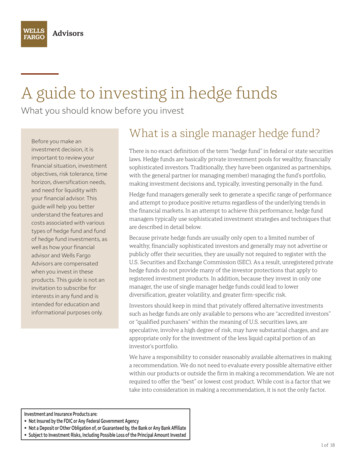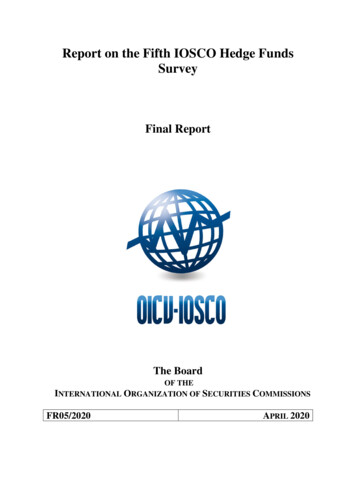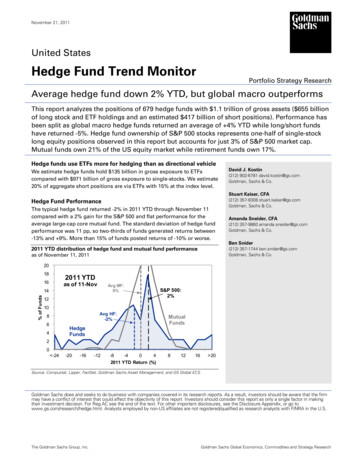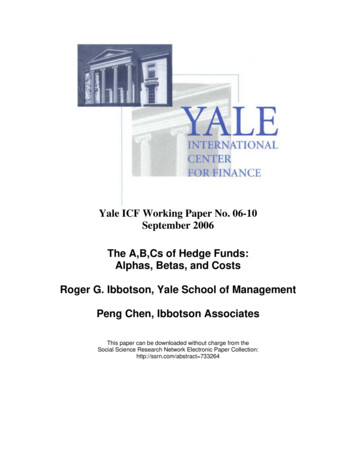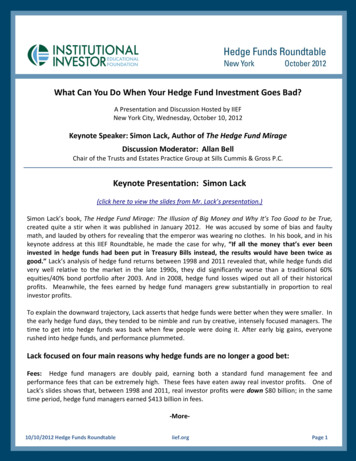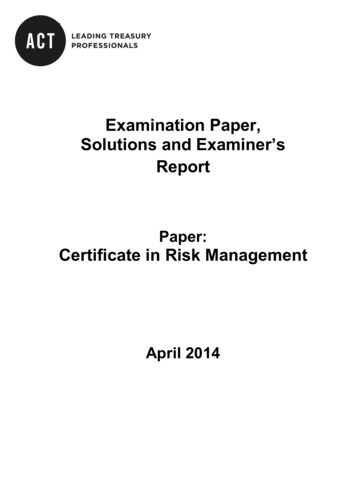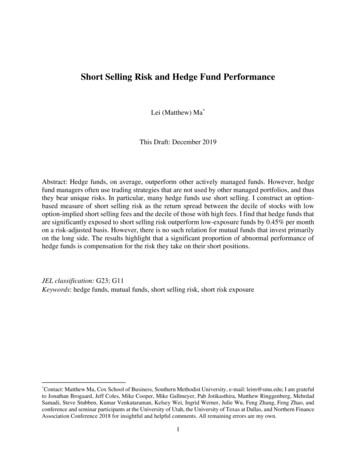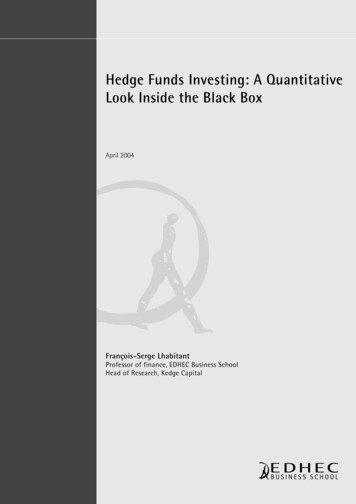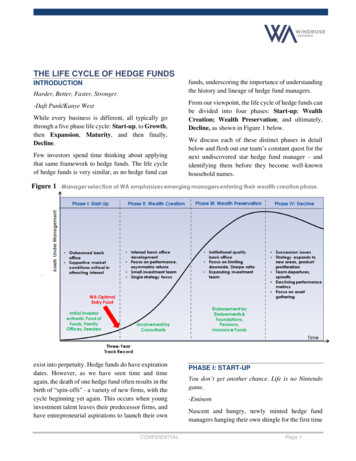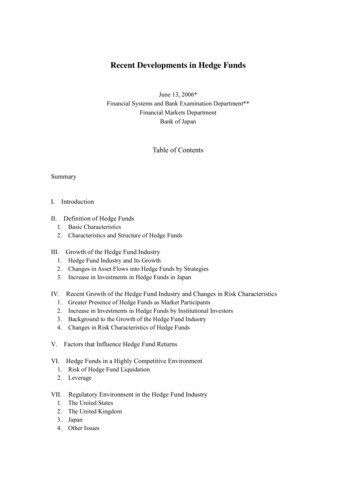
Transcription
Recent Developments in Hedge FundsJune 13, 2006*Financial Systems and Bank Examination Department**Financial Markets DepartmentBank of JapanTable of ContentsSummaryI.IntroductionII.1.2.Definition of Hedge FundsBasic CharacteristicsCharacteristics and Structure of Hedge FundsIII.1.2.3.Growth of the Hedge Fund IndustryHedge Fund Industry and Its GrowthChanges in Asset Flows into Hedge Funds by StrategiesIncrease in Investments in Hedge Funds in JapanIV.1.2.3.4.Recent Growth of the Hedge Fund Industry and Changes in Risk CharacteristicsGreater Presence of Hedge Funds as Market ParticipantsIncrease in Investments in Hedge Funds by Institutional InvestorsBackground to the Growth of the Hedge Fund IndustryChanges in Risk Characteristics of Hedge FundsV.Factors that Influence Hedge Fund ReturnsVI. Hedge Funds in a Highly Competitive Environment1. Risk of Hedge Fund Liquidation2. LeverageVII.1.2.3.4.Regulatory Environment in the Hedge Fund IndustryThe United StatesThe United KingdomJapanOther Issues
VIII. Recent Issues Concerning Hedge Funds1. Counterparty Risk Management and Disclosure2. Consideration of “External Effects”3. Recent Global Issues and Policy ResponsesAppendix: Background Details on Statistical Methods and ModelsAttachment:The Legal System Concerning Hedge Funds in the United States, the UnitedKingdom, and Japan* This is an English translation of the Japanese original released in July 2005 in the Nippon GinkoChousa Kiho (Bank of Japan Research Bulletin).** The former Financial Systems Department.
SummaryDefinition of Hedge FundsHedge funds are becoming increasingly prominent in global financial markets. Althoughhedge funds and investment trusts are both forms of pooled investment vehicles, hedgefunds are characterized by greater freedom for investment managers in terms of investmentstrategies. This is because hedge funds’ investor base is limited to institutional investorsand high net worth individuals, exempting them from the constraints of various regulations,and because they commonly place restrictions on investors’ withdrawal of funds.Growth of the Hedge Fund Industry and Changes in Risk CharacteristicsSince the 1990s, the hedge fund industry has grown both in asset size and in number offunds. Investments in hedge funds by institutional investors have increased markedlysince 2002. In Japan, pension funds and financial institutions, in particular, have increasedinvestments in hedge funds. Such increase in investments into hedge funds has beensupported by a low interest rate environment in major economies and by an increase indemand from investors to diversify their assets. Analyses using publicly available data,although there are some data constraints, reveal that in recent years (1) hedge fundsproduced positive returns regardless of stock and bond market performance; (2) volatility ofhedge fund returns was lower than that of stocks; and (3) portfolio diversification could beexpected from investing in hedge funds, as the correlation of returns between hedge fundsand traditional assets was low.Such risk-return properties of hedge funds may havematched investor demand.Hedge funds have become increasingly active in a variety of markets, exploiting newinvestment strategies as they grow in size and investor base, and have contributed toenhancing efficiency and liquidity in global financial markets.Accordingly, the riskcharacteristics of hedge funds have changed. Data show that in the few years after 2002,compared to the late 1990s, which coincided with the Long-Term Capital Management(LTCM) crisis, (1) returns of hedge funds and their volatility were lower and (2) incidentswhere hedge funds incurred large losses that exceeded maximum losses calculated by Valueat Risk (VaR) were fewer. Meanwhile, investors have become more conscious of riskmanagement and less keen on investing in hedge funds that use extraordinary levels ofleverage, and leverage levels taken by hedge funds seem to have declined. Investors arealso more careful to avoid concentrating their investments in certain hedge funds becausehedge funds tend to be quickly weeded out in terms of “survival of the fittest.”1
Regulatory Environment in the Hedge Fund IndustryIn the United States, the Securities and Exchange Commission (SEC) amended regulationsto place tighter restrictions on investment managers.In the United Kingdom, a newcollective investment vehicle that has the characteristics of hedge funds, called theQualified Investor Schemes, was introduced for institutional investors. In some Europeanand Asian countries, building a legal environment to allow hedge funds to target retailinvestors has been contemplated in recent years. Although the directions of changes arenot uniform, legal developments with respect to hedge funds have been noted. Thesechanges are all being made to find the appropriate balance between ensuring a wide rangeof investment options for investors and protecting investors.Recent Issues concerning Hedge FundsHedge funds, on the whole, seem to be taking less risk in recent years. However, there aresome that take high risk, and when the global financial environment permits, more fundsmay be inclined to do so in seeking higher returns. Given their growing presence in theglobal financial markets recently, it cannot be denied that large losses by or default of hedgefunds may not only affect their counterparties and investors, but also have wide-rangingexternal effects on liquidity and the price discovery process in global financial markets.Therefore, it is vital to pay close attention to hedge fund activities and their effects.In the discussion of hedge fund developments in global financial markets, two issues cometo the fore: (1) exploring ways to enhance information disclosure on hedge funds and riskmanagement by counterparties and investors of hedge funds; and (2) understanding theinfluences that hedge fund activities or default have on global financial markets andsystems.While there are outstanding issues to be addressed, much progress has been noted in riskmanagement by counterparties of hedge funds since the LTCM crisis. However, it isnecessary to continuously check counterparties’ risk management standards so that they willnot be lowered when the environment becomes more competitive. The widely held viewin regard to information disclosure on hedge fund activities is that having counterparties andinvestors obtain necessary information to manage risk from hedge funds is more efficientand effective than uniformly imposing statutory requirements on hedge funds.Hedge fund activities and their influences need to be monitored, even though there are dataconstraints, with a focus on the following two issues in particular. One is whether there is2
a risk that hedge fund activities might destabilize markets if hedge fund transactionsbecome concentrated on similar strategies or pressured to use high-risk strategies in marketenvironments where profit opportunities are few. The second is whether there is a risk thatmarket liquidity might dry up with the exit of hedge funds.In these circumstances, financial authorities including central banks have been examiningrisk management systems of financial institutions including banks and securities firms, fromthe perspective that these market players are counterparties and investors of hedge funds.Furthermore, financial authorities have been discussing ways to adequately monitor marketdevelopments in hedge funds, such as enhancing information exchange in international foraand supporting efforts to improve databases on hedge funds.3
I. IntroductionHedge funds, which are a type of investment vehicle, are becoming increasingly prominentin global financial markets.Hedge funds are commonly defined as “any investmentvehicle that is privately organized, administered by professional investment managers, andnot widely available to the public.”1There is, however, no generally accepted definition,and the term may encompass investment vehicles that invest in many different types offinancial assets and employ a wide array of investment strategies.The history of hedge funds dates as far back as 1949, but they gained widespreadrecognition when the hedge fund founded by George Soros reportedly drove the Britishpound out of the Exchange Rate Mechanism (ERM) in the 1992 European Currency crisis.Later, the extraordinary losses incurred by the Long-Term Capital Management (LTCM), aU.S.-based hedge fund, and its near-collapse in 1998 raised concerns about the influence ofhedge funds on the stability of financial markets and systems and prompted variousdiscussions.Asset inflows into hedge funds were subdued after the near-collapse of LTCM, but haveincreased significantly in recent years, as investors’ demand for yields and diversification ofrisk has grown amidst low interest rate environments in major economies.This paper is structured as follows. Section II describes the characteristics of hedge fundsand distinguishes hedge funds as a type of financial asset. Section III depicts the growthof the hedge fund industry after the LTCM crisis.Section IV portrays the growingpresence of hedge funds in financial markets, and analyzes the risk characteristics of hedgefunds. Sections V and VI consider factors influencing hedge fund risk characteristics andthe competitive environment in which hedge funds operate.Section VII outlines theregulatory environment, including recent changes, in major economies including Japan.Finally, Section VIII presents some observations on the prevailing views on hedge fundsaround the globe, empirical analyses, and recent efforts of financial authorities includingcentral banks in this arena.1This is quoted from the “Report of The President’s Working Group on Financial Markets on HedgeFunds, Leverage, and the Lessons of Long-Term Capital Management” (1999, “The President’sWorking Group Report” hereafter). The Working Group was set up following the LTCM crisis andcomprised of the U.S. Department of Treasury, the Board of Governors of the Federal ReserveSystem, the Securities and Exchange Commission, and the Commodity Futures TradingCommission.4
II. Definition of Hedge Funds1. Basic CharacteristicsHedge funds, as compared to investment trusts,2generally have the followingcharacteristics.(1) Greater freedom of investment strategies for investment managers:Hedge funds generally limit their investors to institutional investors and high net worthindividuals, namely those who do not require much investor protection. They often preferprivate offerings over public offerings in raising funds, securing greater freedom ofinvestment strategies compared to investment trusts, such as taking short positions in stocksand using derivatives flexibly. In addition, they are scarcely subject to regulations andsupervision by financial authorities, and heavy requirements for disclosure.(2) Investment strategies pursuing “absolute returns”:Generally, investment trusts benchmark their performance against stock or bond markettrends and target higher returns relative to these trends, so their performance evaluation isalso in relative terms. Hedge funds, in contrast, pursue absolute returns, where a certainlevel of returns not linked to market trend, is expected.(3) Compensation for investment managers is linked to their funds’ performance:Hedge funds are managed by investment managers.3Investment managers typicallyreceive a 10–20% incentive fee on top of the 1–2% management fee (Chart 1).Inaddition, investment managers frequently commit their own money in the hedge funds theymanage.2In this paper, the term “investment trust” will be used to refer to the most common mutualfund-type investment vehicles in Japan. Unlike mutual funds in the United States, most of theseinvestment trusts are contractual type.3Incentive fees often take the form of a “high water mark” that bases compensation for investmentmanagers on only the portion of the net asset value that exceeds historical highs. Approximately72% of all hedge funds registered in the Lipper Tass Database as of March 2005 adopt this type ofcompensation scheme.5
(Chart 1) Incentive Structure for Investment Managers (share, %)Management FeeFee for net assetsFee for net profitsover 2%over 20%2% and below20% and below1.5% and below15% and below1% and below10% and below0.5% and below5% and below0%10%20%30%40%Share of hedge funds0%Incentive Fee20%40%60%80%Share of hedge fundsNote: Based on 3071 hedge funds registered in Lipper TASS Database as of March 2005.Source: Lipper TASS Database2. Characteristics and Structure of Hedge Funds(1) Characteristics of hedge fundsThe characteristics of hedge funds may vary depending on the legal framework in variouscountries and schemes they employ, but they typically share the following characteristics,and have similar subscription and withdrawal processes. Hedge funds generally do notraise funds by public offerings but rather by private offerings. Therefore, investors oftenfind the hedge fund matching their needs by using research companies, so-called“gatekeepers,” that assess the risks and returns of individual funds and provide informationon hedge funds when investing in hedge funds.Investors choose a fund by first obtaining a prospectus from individual hedge funds andcarefully evaluating the information. Upon deciding to invest, investors mail the requiredpaperwork such as the application form to the party designated in the prospectus andtransfer money to the designated bank account. Purchase dates are typically limited tocertain days of the month, such as the month-end, and the purchase application and paymentneed to be made within the specified term before the purchase dates. Many funds set aminimum investment requirement of 100,000 U.S. dollars, or approximately 10 million yen(Chart 2).6
(Chart 2) Minimum Investment Requirements of Hedge Funds (share, %) 5 mil. and over 1 mil. and over 500 thous. and over 100 thous. and over 10 thous. and overHedge FundsFunds of Hedge Fundsbelow 10 thous.0%5%10%15%20%25%30%35%440%45%Note: Based on 2397 hedge funds registered in Lipper TASS Database and reporting relevant data inU.S. dollars as of March 2005.Source: Lipper TASS DatabaseInvestors have two ways to withdraw funds from hedge funds, namely distributions andtermination of investments. Whether distributions are paid out depends on contracts withindividual investors. In many cases, hedge funds pay distributions to investors in Japan.In most other countries, hedge funds do not pay distributions to investors, so money isgenerally kept in the fund as retained earnings. Various constraints are often set forinvestors to terminate investments in the fund. In many cases, investors are allowed toterminate investments only on certain dates such as specified days of the month or quarter(Chart 3.1). To apply for termination, investors need to notify the hedge fund of theirintentions well ahead of the specified date for termination application, and actual paymentwill only be made after a predetermined period. The period between the terminationapplication date and pay-out date may exceed 60 days (Chart 3.2). In addition, investorsare not allowed to terminate investments for a certain period from the starting date, theso-called “lock-up period” (Chart 3.3). Lock-up periods are not always binding and mayvary across hedge funds and with each investor. Investors may be allowed terminationwithin shorter periods by paying extra fees, while hedge funds may also reserve the right toextend the period needed for termination when exceptional events like market turbulenceoccur.4Funds that invest in a number of other hedge funds.7
(Chart 3) Liquidity Constraints of Hedge Funds (share, %)Single Hedge FundsFunds of Hedge Funds1. Redemption FrequencyBiennially/Triennially0.2%Annually5.1%Not Fortnightly/Semi-monthly0.6%Semi-annually3.0%Not rterly34.2%Monthly49.1%2. Payout PeriodOver 180 days0.4%Within 5 daysWithin 1808.7%days7.4%Within 90days16.9%Monthly55.9%Within 10days4.3%Within 20days9.1%Within 180days21.3%Within 30days15.1%Within 60days38.1%Within 5 days4.7%Within 10daysWithin 201.8%days5.8%Within 30days9.4%Within 90days28.0%Within 60days29.0%3. Lock-up PeriodWithin 6months3.5%Within 12months24.2%Within 3months1.6%Within 24months0.8%Within 12monthsWithin 6 19.1%months2.2%Within 36months0.8%Within 3months0.7%No lock-up69.2%Within 24months0.4%Within 36months0.4%Within 72months1.0%No lock-up76.3%Note: Based on 2256 single hedge funds and 817 funds of hedge funds registered in Lipper TASSDatabase as of March 2005. As for the lock-up period, “No lock-up” includes hedge funds thatallow withdrawal at any time in return for a relatively higher fee.Source: Lipper TASS DatabaseWhen viewed as financial products, hedge funds are less liquid than investment trusts andgovernment bonds, due to stricter constraints for subscription and termination.5Suchliquidity constraints for investors allow investment managers to set longer investment timehorizons, thus helping to pursue a certain level of performance required by investors.5Funds of hedge funds often have lower minimum investment requirements but take longer to payout compared to single hedge funds (Charts 2, 3).8
(2) Structure of hedge funds (Chart 4)The basic structure of hedge funds consists of an investment vehicle where investmentfunds are pooled and investment managers who give instructions on investments of theinvestment vehicle. The term “hedge fund” generally refers to the investment vehicle, butmay include investment managers as well. This paper follows such conventional use ofthe term unless there is room for misunderstanding.(Chart 4) Example of Hedge Fund StructureInvestors AInvestors BInvestors CTax havenEstablishment of vehicles in response tofinancial regulations, tax systemsFeeder fund A(Vehicle)Investment manager(Investment adviser)InvestmentorderFeeder fund B(Vehicle)Master fund(Vehicle)Feeder fund C(Vehicle)Settlement andclearing of trades,Lending of securitiesand fundsPrime brokerRecord of trades,Valuation of net assetsAdministratorCustodial servicesCustodianInvestmentsService offersTarget financial assetsHedge funds that target U.S. investors are typically limited partnerships domiciled in theUnited States (Chart 5). Those that target investors in countries other than the UnitedStates, including Japan, are often set up as investment companies, trust companies, orlimited partnerships domiciled in offshore tax havens like the Cayman Islands. Severalsub-funds, so-called “feeder funds,” may be established under the master fund to coverinvestors who may face different financial and tax regulations.66A structure known as “parallel funds,” involving several funds that each specializes inaccommodating investors in a specific legal and tax environment, can achieve similar objectives. Amaster fund does not exist in this structure, and the overall returns are allocated to each fundaccording to predetermined conditions in the contract.9
(Chart 5) Fund Domicile (share, nds33%Bermuda8%Virgin Island(British)11%United States31%Note: Based on 3071 hedge funds registered in Lipper TASS Database as of March 2005.Source: Lipper TASS DatabaseSome investment managers of hedge funds targeting investors in Asia and Oceania reside incountries within the region, such as Japan, Australia, Hong Kong, or Singapore, but mostinvestment managers reside in the United States or United Kingdom (Chart 6). Investmentmanagers are sometimes employed by large financial institutions or investment advisorycompanies, but are usually independent from such organizations.(Chart 6) Location of Investment Managers (share, %)Singapore1%Australia1%Hong Kong1%Japan0.4%Others17%France3%Bermuda6%United States52%United Kingdom19%Note: Based on 3048 hedge funds registered in Lipper TASS Database as of March 2005. This chartshows the top 4 areas all over the world and those in Asia and Oceania.Source: Lipper TASS Database10
In addition, the following parties provide services for hedge funds.a. Prime brokers:Prime brokers supply hedge funds with clearing and settlement of trades, as well as lendsecurities and cash to them. They sometimes provide other services such as giving advicefor establishing new hedge funds and introducing investors. One hedge fund may use theservices of more than one prime broker.The prime brokerage business is currentlydominated by a handful of major investment banks.In Japan, the prime brokerage services are mainly provided by Japanese branches of foreignsecurities firms, and the role played by Japanese banks and securities firms is still limited.b. Administrators:The main tasks of administrators are keeping the books, calculating the net asset value(NAV) of funds based on the valuation of assets, and reporting to investors. Even thoughassets invested by hedge funds are often illiquid and their market values are not alwaysexplicit, the evaluation of NAV is crucial, because hedge fund performance and investmentmanager compensation are calculated based on NAV. Such services are provided byprime brokers and investment managers in some cases.c. Custodians:Custodians are often entrusted with the safe-keeping of hedge fund assets such as securitiesand deposits. Prime brokers often provide custodian services.III. Growth of the Hedge Fund Industry1. Hedge Fund Industry7 and Its GrowthSince 1990, the hedge fund industry has grown 37 times in asset volume and 12 times innumber of hedge funds (Chart 7). It is also expected to grow by another 60 to 70% andreach 1.7 trillion U.S. dollars in asset volume and 11,700 in number of funds by 2008 (VanHedge Fund Advisors).However, the amount of assets invested in hedge funds accounts for only about 1% of thetotal global financial assets.7Hereafter, the hedge fund industry as mentioned in this paper will include funds of hedge fundsthat invest in other hedge funds, unless otherwise stated.11
(Chart 7) Estimated Amount of Assets and Number of Funds in Hedge Fund Industry1000900800700Number of fundsbillion U.S. dollars90008000Net Assets (left scale)7000Number of Funds (right 1985 1990 1995 1996 1997 1998 1999 2000 2001 2002 2003 2004Sources: Hennessee Group LLC; Hedge Fund Research; International Financial Services, LondonThe asset size and number of funds of hedge funds (FoHFs) have increased 3.5 times from2001 to 2004 (Hedge Fund Research). This increase was supported by growing interestfrom institutional investors who have increased their investments in hedge funds in recentyears, because investments in FoHFs offer merits such as wider risk diversification andlower minimum investment amounts compared to investments in single hedge funds (Chart2).2. Changes in Asset Flows into Hedge Funds by StrategiesHedge funds are often categorized by the investment strategies they employ. For example,funds that take long positions on undervalued stocks and short positions on overvaluedstocks are called “Long/Short Equity” funds.Those that invest in convertible bondscombined with credit derivatives or stocks and take advantage of arbitrage trading amongthese assets are called “Convertible Arbitrage” funds (Box 1). Cumulative assets investedinto hedge funds have increased for most strategy-type hedge funds (Chart 8).12
(Chart 8) Changes in Cumulative Asset Flows by Strategies (Year-on-year)200%200%1501702.6% (1995), 467.9% (1996)150100501000-5050-100-1500-200-250-501995 1996 1997 1998 1999 2000 2001 2002 2003 20041995 1996 1997 1998 1999 2000 2001 2002 2003 2004Convertible ArbitrageDedicated Short BiasFixed Income ArbitrageGlobal MacroEquity Market NeutralEvent DrivenLong/Short EquityManaged FuturesSource: Tremont Capital ManagementHedge funds that employ investment strategies based on their views on the global economy,the so-called “Global Macro” funds, accounted for a dominant 70% of the hedge fundindustry in the early 1990s but their share plunged as investors withdrew assets from thesefunds following the LTCM crisis.On the other hand, hedge funds that take neutralpositions on the market overall and find arbitrage opportunities on individual securities,namely arbitrage-type-strategy funds, have been attracting increasing amounts of assetsfrom investors, and their market share has been increasing.Looking at the share of hedge funds by strategies, hedge funds that take directionalpositions in certain markets, such as “Long/Short Equity” funds or “Global Macro” funds,account for one-third of the total amount of hedge funds in the Credit Suisse/TremontHedge Fund Index as of March 2005 (Chart 9). Arbitrage-type-strategy funds that takeadvantage of price anomalies between individual securities such as “Fixed IncomeArbitrage” funds and “Equity Market Neutral” funds, and “Event Driven” funds that captureprice movements generated by significant corporate events such as mergers and acquisitionsaccount for approximately 20% of the industry, respectively.13
(Chart 9) Strategy Composition in Credit Suisse/TremontHedge Fund Index (March 2005)Others17%Long/ShortEquity25%Event Driven23%Global M acro11%ConvertibleArbitrage4%M anaged Futures5%Equity M arketNeutral5%Note: Asset weighted shares.“Multi-Strategy.”Source: Credit Suisse/TremontFixed IncomeArbitrage9%Dedicated ShortBias1%“Others” includes “Emerging Markets” strategy and[Box 1] Major Strategies of Hedge FundsHedge fund strategies can be divided into three main categories: (1) arbitrage strategies that take advantageof price discrepancies to generate returns, (2) directional strategies that base returns on views on marketdirections, and (3) event driven strategies that focus on exceptional events.In addition, there are otherstrategies such as “Multi-Strategy” that use several strategies within a fund and “Emerging Markets” thattarget specific regions (Box Chart).Hedge fund strategies are diverse and databases may employ differentcategorizations, and some hedge funds do not fall under any of the categories specified.categories used by the Credit Suisse/Tremont are applied.14In this paper, the
Hedge FundSingle FundOthers (Multi-Strategy,Emerging Markets)Fund of Hedge FundsF3 (Fund of Fundsof Hedge Funds)(1) Arbitrage(2) Directional(3) Event DrivenConvertible ArbitrageLong/Short EquityRisk (Merger) ArbitrageFixed Income ArbitrageGlobal MacroDistressedEquity Market NeutralManaged FuturesDedicated Short BiasNote: Strategies used in the analyses are shown in gray boxes.StrategyConvertible ArbitrageFixed Income ArbitrageEquity Market NeutralLong/Short EquityGlobal MacroManaged FuturesDedicated Short BiasEvent DrivenDescriptionThis strategy makes use of price relationships between convertible bonds andother securities. A typical investment is to be long on convertible bondsand short on common stocks of a company.This strategy focuses on price anomalies between related fixed incomesecurities and takes profits from the normalization process.Maininvestment targets include public and corporate bonds, asset-backedsecurities, and derivative products such as swaps.This strategy typically involves holding long and short matched equityportfolios, and taking advantage of price anomalies. This means being betaneutral, seeking to generate steady returns regardless of market fluctuations.This strategy involves, for example, being long on stocks whose prices areexpected to rise and short on stocks whose prices are expected to decline.The purpose is to generate returns while limiting the influences of marketvolatility. Positions may be net long, net short, or market neutral. Manyfunds in this category seem to have gained returns from their long positions,and so a greater number of funds tend to take long-biased positions.This strategy seeks investment opportunities in a wide range of marketsincluding bonds, foreign exchange, commodities, and derivatives acrossmany economies to generate returns from price anomalies or the direction ofmarket movements.This strategy seeks investment opportunities in a wide range of futuresmarkets such as equities, interest rates, currencies, and commodities.Commodities Trading Advisors fall under this category. There are fundsthat not only trade on prices but also on technical indices.This strategy maintains net short positions, mostly in stocks and derivatives.This strategy tries to capture price movements stemming from significantcorporate events such as mergers and acquisitions, restructuring,insolvencies, and defaults.Source: Credit Suisse/Tremont15
3. Increase in Investments in Hedge Funds in JapanLooking at the situation in Japan, institutional investors such as pension funds and financialinstitutions, in particular, have stepped up their investments in hedge funds steadily inrecent years as they increase alternative investments to diversify risks away from traditionalassets such as stocks and bonds. The results of several studies show that investmentamounts have grown 7 times and the number of investors has increased more than 10 timessince 2000 (Chart 10). The results of a questionnaire survey on corporate pension funds inJapan reveal that approximately 70% of the funds perceive hedge funds as an asset to beinvested in in the future (Chart 11).(Chart 10) Hedge Fund Investments by Japanese Investors4.5trillion yen4.0OthersPension FundsBanksInsurance 003End of yearNote: Yen-dollar exchange rates at the end of each year applied to yen conversions of original data.Source: Alternative Investment Products Co., Ltd.16
(Chart 11) Newly Intended Investments by Corporate Pension Funds010Enhanced IndexPrivate Equity20304045.2413.316.67M anaged Futures3.215.56High-yield Bond2.385.5623.8116.67Floating-rate Bon
recognition when the hedge fund founded by George Soros reportedly drove the British pound out of the Exchange Rate Mechanism (ERM) in the 1992 European Currency crisis. Later, the extraordinary losses incurred by the Long-Term Capital Management (LTCM), a U.S.-based hedge fund, and its near-collapse in 1998 raised concerns about the influence of
